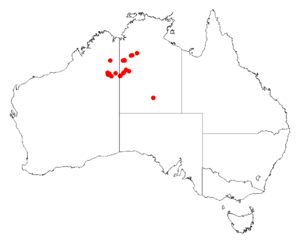Mullan wattle facts for kids
Quick facts for kids Mullan wattle |
|
|---|---|
| Scientific classification | |
| Genus: |
Acacia
|
| Species: |
maconochieana
|
 |
|
The Mullan wattle, also known by its scientific name Acacia maconochieana, is a special type of shrub or small tree. It belongs to the Acacia family, which is a very large group of plants. This wattle is endemic, meaning it only grows naturally in a specific dry (arid) part of central Australia.
What the Mullan Wattle Looks Like
The Mullan wattle is usually a shrub or a small tree. It can grow to be about 2.5 to 12 metres (8 to 39 ft) tall. Its bark is grey and has long cracks in it. The small branches are covered in dense hairs.
Like many Acacia species, the Mullan wattle does not have true leaves. Instead, it has special flattened stems called phyllodes. These phyllodes look like leaves and help the plant make food.
The phyllodes of the Mullan wattle are hairy and stay green all year. They are long and thin, measuring about 8 to 18 cm (3.1 to 7.1 in) in length and 2 to 5 mm (0.079 to 0.197 in) in width. They have many fine lines running along them. The Mullan wattle blooms in October, producing bright yellow flowers.
How the Mullan Wattle Got Its Name
The Mullan wattle was first officially described by a botanist named Leslie Pedley. A botanist is a scientist who studies plants. Pedley wrote about this new species in 1986. His description was published in a science journal called Austrobaileya.
For a short time, in 2003, the plant was reclassified into a different group called Racosperma. However, in 2006, it was moved back to the Acacia group, where it remains today.
Where the Mullan Wattle Grows
The Mullan wattle is found in specific parts of Australia. It grows naturally in the Northern Territory and in the Kimberley and Goldfields-Esperance regions of Western Australia.
You can often find this plant growing near lakes that sometimes flood. It prefers sandy or loamy soils. Its natural home stretches from Gregory Salt Lake in the west all the way to Nongra Lake in the Tanami Desert in the east. In these areas, it is usually part of low forests, woodlands, or open scrubland.

